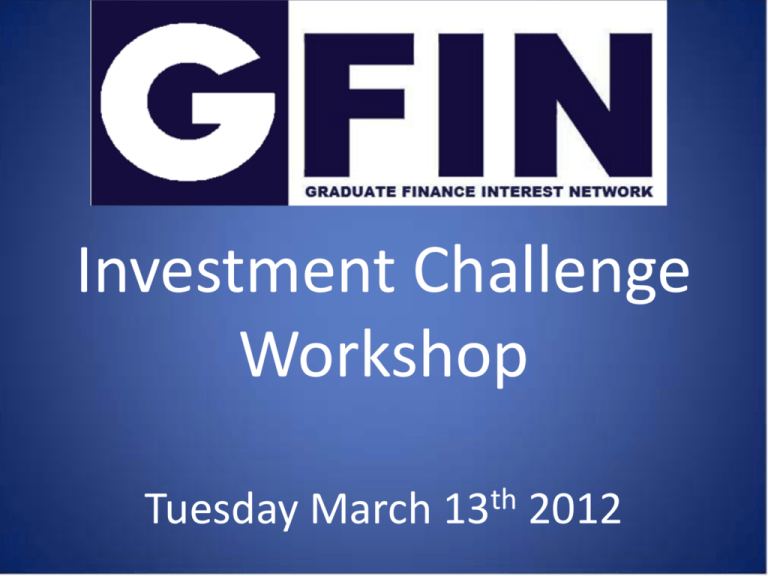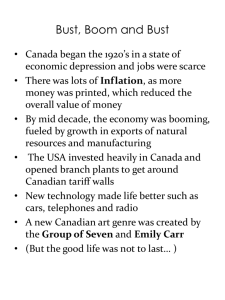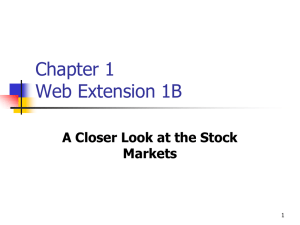Andrew McCoy's powerpoint
advertisement

Investment Challenge Workshop Tuesday March 13th 2012 Disclaimer The following information is not intended to be personal financial advice or recommendations to buy or sell any security. It is for purposes of the GFIN Investment Challenge trading simulation only. GFIN Investment Challenge Spring 2012 • What is it? – A fundraiser for GFIN • What are the prizes? – Entry fees split up among GFIN and top three portfolio managers. – Example: 30 people participating • • • • • Entire collection pot: 30x$10 = $300 50% to GFIN: $150 25% to first place: $75 15% to second place: $45 10% to third place: $30 Basic Terminology: Trading • Exchange –Ex. New York Stock Exchange (NYSE) • Ticker symbol –Ex. NYSE:WMT Basic Terminology: Trading • Stock – Certificate that represents a claim on the company’s assets and earnings. • Bond – A loan granted to an entity in exchange for a fixed amount of interest. • ETF (Exchange Traded Fund) – A composition of many stocks, bonds or both, but trades under one symbol. Basic Terminology: Trading • Buying on margin (borrowing to invest) –Offers the potential for greater reward by taking on more risk. • Trading long vs. trading short • Order types –market –limit Real world examples: 1. Buying on margin 2. Selling short on margin Buying on Margin • Long position on shares of Target (TGT) • Buy 10,000 shares @ $57.75 per share = $577,500 (total value of position) • Cash required to initiate this position: 50% of total value of position = $288,750 • The other half is borrowed from your broker and a monthly interest charge is applied. • This is called “buying on margin.” • $288,750 (cash) + $288,750 (borrowed) = $577,500 Selling short on Margin • Short position on shares of Yelp Inc. (YELP) • Sell short 15,000 shares @ $22.85 = $342,750 (cash deposited into account from short sale) • Extra cash required as collateral to initiate this position is 50% of the value of the shares sold short. = $171,375 How Investopedia handles margin • Buying Power: The total value of your cash and margin accounts that can be used to trade stocks. • Buying Power is Calculated as: =cash + (Long Stocks x 50%) - (Shorted Stocks x 150%) • Negative buying power indicates that no further trading can be performed and that margin call will occur. • Possible to have negative cash Fundamental Analysis Fundamental Analysis for Exxon Mobil Data taken from Google Finance Price to Book calculation for Exxon Mobil Book Price per share = total assets – total liabilities shares outstanding Price to Book ratio = stock price book price per share $331,052,000 – $176,656,000 4,734,000 = $32.61 book price per share $85.41 (share price) $32.61 (book price per share) = 2.62 P/B ratio Technical Analysis Exxon Mobil 1 year chart Selling pressure β = 0.5 Short term trend turning up Selling pressure Investopedia.com How to make your first trade After logging into your Simulator account, click on the "Trade" tab near the top of the screen. In the Trade screen, type in ‘WMT' in the Symbol field and ‘100' in the Quantity field, leaving all other fields at their default settings, as shown here: Putting it all together • Trading strategies and techniques: – Strategies: • 1. High beta (β>1.2) – Good for volatile market • 2. Low beta (β<0.8) – Lower risk, less movement in the stock • 3. Trade the trend – Go with the market trend • 4. Contrarian – Go against the market trend – Techniques: • Narrow diversification (choosing 10 or less securities) – High risk (putting all your eggs in one basket) • Broad diversification (choosing more than 10 securities) – Lowers the risk of one bad stock ruining the whole portfolio References • • • • • www.google.com/finance www.investopedia.com/university www.stockcharts.com www.seekingalpha.com www.go.uic.edu/gfin Definitions • Market Capitalization – share price multiplied by the number of shares outstanding. • P/E ratio – stock price per share divided by earnings per share • P/B ratio – stock price per share divided by book value per share • Profit Margin % – net income divided by revenue • Total debt/Assets % – total debt divided by total assets • 10 yr. EPS growth – earnings per share growth expressed as % increase over the past 10 years • Dividend- actual $ per share and % yield • Moving average - 200 day, 50 day • Daily Volume – the actual number of shares traded per day • Beta - Measure of volatility as compared to the S&P 500 • RSI Indicator- Relative strength indicator • MACD indicator – momentum indicator











